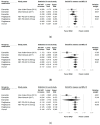Antidiabetic Agents for Treatment of Parkinson's Disease: A Meta-Analysis
- PMID: 32635358
- PMCID: PMC7369739
- DOI: 10.3390/ijerph17134805
Antidiabetic Agents for Treatment of Parkinson's Disease: A Meta-Analysis
Abstract
Background: Clinical and epidemiological studies suggest that two of the most common geriatric diseases, type 2 diabetes and Parkinson's disease (PD), are linked. These studies notably suggest that treatment of insulin resistance in type 2 diabetes may beneficially modify the pathophysiology of PD and help to maintain motor and nonmotor function. In this meta-analysis, we evaluate the efficacy of new antidiabetic agents in the treatment of PD. Methods: We systematically searched PubMed, Medline, ProQuest, ScienceDirect, ClinicalKey, and Cochrane Library from the date of their inception until 15 March 2020. Multiple efficacy parameters were compared between treatment groups. The results are expressed as mean differences with 95% confidence intervals (CIs) in a random-effects model. Results: A meta-analysis of the data extracted from three randomized control trials revealed that treatment with exenatide yielded significant improvements in scores on the Unified Parkinson's Disease Rating Scale Part I (UPDRS-I) (-0.438, 95% CI, -0.828 to -0.048, p = 0.028), UPDRS Part IV (UPDRS-IV) (-0.421, 95% CI, -0.811 to -0.032, p = 0.034) and the Mattis Dementia Rating Scale (MDRS) (-0.595, 95% CI, -1.038 to -0.151, p = 0.009). At the 12-month follow-up, the UPDRS Part III (UPDRS-III) scores in the off-medication phase revealed significant improvements in patients using exenatide (-0.729; 95% CI, -1.233 to -0.225, p = 0.005). Treatment with pioglitazone did not yield significant improvements in UPDRS, MDRS, or Parkinson's Disease Questionnaire scores. Conclusion: This meta-analysis suggests that exenatide use is associated with the alleviation of cognitive, motor and nonmotor symptoms. However, long-term studies with a large sample size of patients with PD of varying severity are required.
Keywords: Parkinson’s disease; Thiazolidinedione; antidiabetic agent; glucagon-like peptide 1; meta-analysis.
Conflict of interest statement
The authors report no financial interests or potential conflicts of interest.
Figures





References
-
- Lima M.M., Targa A.D., Noseda A.C., Rodrigues L.S., Delattre A.M., Dos Santos F.V., Fortes M.H., Maturana M.J., Ferraz A.C. Does Parkinson’s disease and type-2 diabetes mellitus present common pathophysiological mechanisms and treatments? CNS Neurol. Disord. Drug Targets. 2014;13:418–428. doi: 10.2174/18715273113126660155. - DOI - PubMed
Publication types
MeSH terms
Substances
LinkOut - more resources
Full Text Sources
Medical

